←
SPACE WATCH
Filigree and Shadow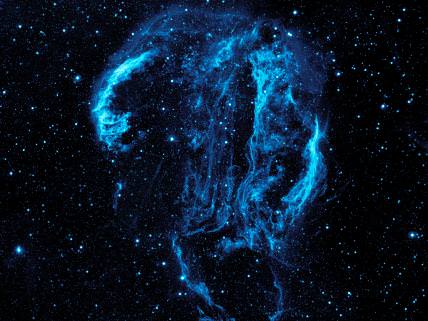 NASA – Wispy tendrils of hot dust and gas glow brightly in this ultraviolet image of the Cygnus Loop Nebula, taken by NASA’s Galaxy Evolution Explorer. The nebula lies about 1,500 light-years away, and is a supernova remnant, left over from a massive stellar explosion that occurred 5,000-8,000 years ago. The Cygnus Loop extends more than three times the size of the full moon in the night sky, and is tucked next to one of the ‘swan’s wings’ in the constellation of Cygnus.
NASA – Wispy tendrils of hot dust and gas glow brightly in this ultraviolet image of the Cygnus Loop Nebula, taken by NASA’s Galaxy Evolution Explorer. The nebula lies about 1,500 light-years away, and is a supernova remnant, left over from a massive stellar explosion that occurred 5,000-8,000 years ago. The Cygnus Loop extends more than three times the size of the full moon in the night sky, and is tucked next to one of the ‘swan’s wings’ in the constellation of Cygnus.
The filaments of gas and dust visible here in ultraviolet light were heated by the shockwave from the supernova, which is still spreading outward from the original explosion. The original supernova would have been bright enough to be seen clearly from Earth with the naked eye. Image Credit: NASA/JPL-Caltech
Related articles
- Galactic Views (21) (theneteconomy.wordpress.com)
- Galactic Views (30) (theneteconomy.wordpress.com)
- Galactic Views (28) (theneteconomy.wordpress.com)
- Galactic Views (18) (theneteconomy.wordpress.com)
- Galactic Views (33) (theneteconomy.wordpress.com)
- Galactic Views (32) (theneteconomy.wordpress.com)
- Galactic Views (29) (theneteconomy.wordpress.com)
- Galactic Views (20) (theneteconomy.wordpress.com)
- Galactic Views (23) (theneteconomy.wordpress.com)
Source: the Net economy
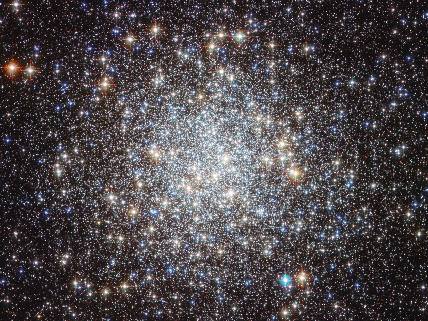 NASA – The Hubble Space Telescope has produced the most detailed image so far of Messier 9, a globular star cluster located close to the center of the galaxy. This ball of stars is too faint to see with the naked eye, yet Hubble can see over 250,000 individual stars shining in it.
NASA – The Hubble Space Telescope has produced the most detailed image so far of Messier 9, a globular star cluster located close to the center of the galaxy. This ball of stars is too faint to see with the naked eye, yet Hubble can see over 250,000 individual stars shining in it.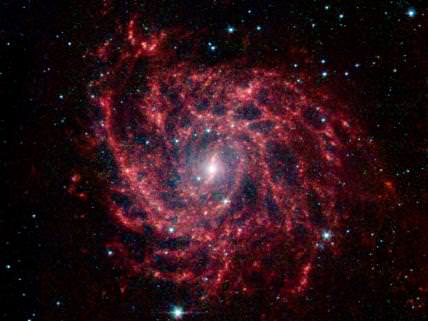 NASA – Looking like a spider’s web swirled into a spiral, Galaxy IC 342 presents its delicate pattern of dust in this image from NASA’s Spitzer Space Telescope. Seen in infrared light, faint starlight gives way to the glowing bright patterns of dust found throughout the galaxy’s disk.
NASA – Looking like a spider’s web swirled into a spiral, Galaxy IC 342 presents its delicate pattern of dust in this image from NASA’s Spitzer Space Telescope. Seen in infrared light, faint starlight gives way to the glowing bright patterns of dust found throughout the galaxy’s disk.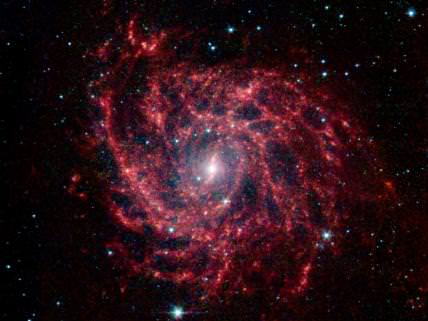 NASA – Looking like a spider’s web swirled into a spiral, Galaxy IC 342 presents its delicate pattern of dust in this image from NASA’s Spitzer Space Telescope. Seen in infrared light, faint starlight gives way to the glowing bright patterns of dust found throughout the galaxy’s disk.
NASA – Looking like a spider’s web swirled into a spiral, Galaxy IC 342 presents its delicate pattern of dust in this image from NASA’s Spitzer Space Telescope. Seen in infrared light, faint starlight gives way to the glowing bright patterns of dust found throughout the galaxy’s disk.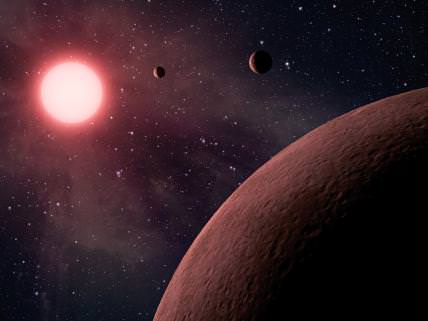 NASA – This artist’s concept depicts a planetary system so compact that it’s more like Jupiter and its moons than a star and its planets. Astronomers using data from NASA’s Kepler mission and ground-based telescopes recently confirmed that the system, called KOI-961, hosts the three smallest exoplanets currently known to orbit a star other than our sun. An exoplanet is a planet that resides outside of our solar system.
NASA – This artist’s concept depicts a planetary system so compact that it’s more like Jupiter and its moons than a star and its planets. Astronomers using data from NASA’s Kepler mission and ground-based telescopes recently confirmed that the system, called KOI-961, hosts the three smallest exoplanets currently known to orbit a star other than our sun. An exoplanet is a planet that resides outside of our solar system.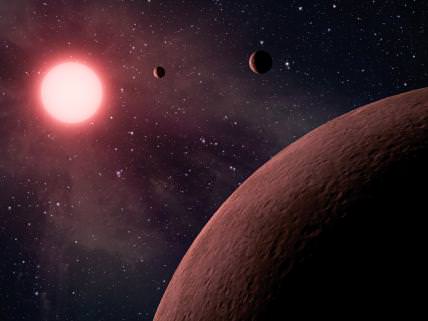 NASA – This artist’s concept depicts a planetary system so compact that it’s more like Jupiter and its moons than a star and its planets. Astronomers using data from NASA’s Kepler mission and ground-based telescopes recently confirmed that the system, called KOI-961, hosts the three smallest exoplanets currently known to orbit a star other than our sun. An exoplanet is a planet that resides outside of our solar system.
NASA – This artist’s concept depicts a planetary system so compact that it’s more like Jupiter and its moons than a star and its planets. Astronomers using data from NASA’s Kepler mission and ground-based telescopes recently confirmed that the system, called KOI-961, hosts the three smallest exoplanets currently known to orbit a star other than our sun. An exoplanet is a planet that resides outside of our solar system.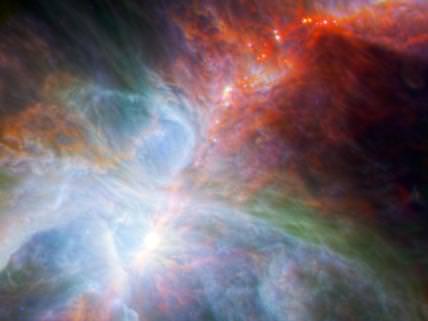 NASA – This new view of the Orion Nebula highlights fledgling stars hidden in the gas and clouds. It shows infrared observations taken by NASA’s Spitzer Space Telescope and the European Space Agency‘s Herschel mission, in which NASA plays an important role.
NASA – This new view of the Orion Nebula highlights fledgling stars hidden in the gas and clouds. It shows infrared observations taken by NASA’s Spitzer Space Telescope and the European Space Agency‘s Herschel mission, in which NASA plays an important role.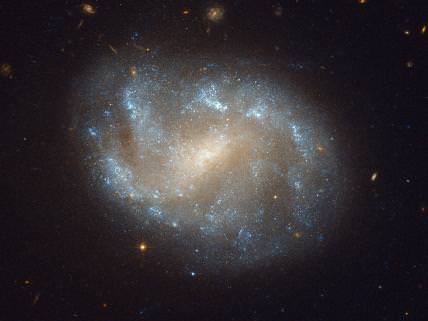 NASA’s Hubble Space Telescope has produced this beautiful image of the galaxy NGC 1483. NGC 1483 is a barred spiral galaxy located in the southern constellation of Dorado — the dolphinfish (or Mahi-mahi fish) in Spanish. The nebulous galaxy features a bright central bulge and diffuse arms with distinct star-forming regions. In the background, many other distant galaxies can be seen.
NASA’s Hubble Space Telescope has produced this beautiful image of the galaxy NGC 1483. NGC 1483 is a barred spiral galaxy located in the southern constellation of Dorado — the dolphinfish (or Mahi-mahi fish) in Spanish. The nebulous galaxy features a bright central bulge and diffuse arms with distinct star-forming regions. In the background, many other distant galaxies can be seen.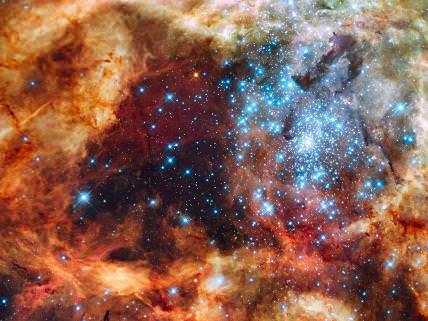 NASA – This massive, young stellar grouping, called R136, is only a few million years old and resides in the 30 Doradus Nebula, a turbulent star-birth region in the Large Magellanic Cloud, a satellite galaxy of the Milky Way. There is no known star-forming region in the Milky Way Galaxy as large or as prolific as 30 Doradus.
NASA – This massive, young stellar grouping, called R136, is only a few million years old and resides in the 30 Doradus Nebula, a turbulent star-birth region in the Large Magellanic Cloud, a satellite galaxy of the Milky Way. There is no known star-forming region in the Milky Way Galaxy as large or as prolific as 30 Doradus.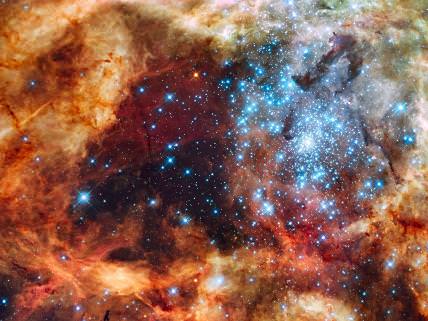 NASA – This massive, young stellar grouping, called R136, is only a few million years old and resides in the 30 Doradus Nebula, a turbulent star-birth region in the Large Magellanic Cloud, a satellite galaxy of the Milky Way. There is no known star-forming region in the Milky Way Galaxy as large or as prolific as 30 Doradus.
NASA – This massive, young stellar grouping, called R136, is only a few million years old and resides in the 30 Doradus Nebula, a turbulent star-birth region in the Large Magellanic Cloud, a satellite galaxy of the Milky Way. There is no known star-forming region in the Milky Way Galaxy as large or as prolific as 30 Doradus.